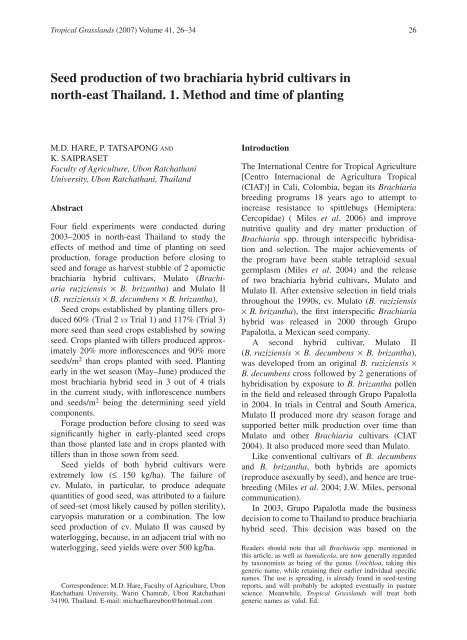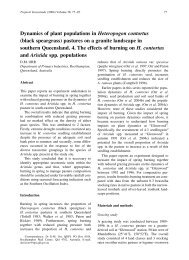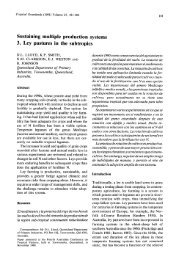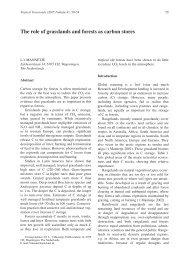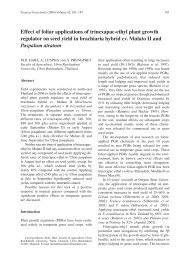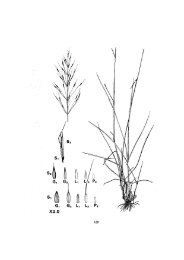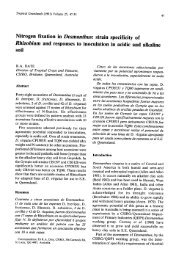Seed production of two brachiaria hybrid cultivars in - Tropical ...
Seed production of two brachiaria hybrid cultivars in - Tropical ...
Seed production of two brachiaria hybrid cultivars in - Tropical ...
You also want an ePaper? Increase the reach of your titles
YUMPU automatically turns print PDFs into web optimized ePapers that Google loves.
<strong>Tropical</strong> Grasslands (2007) Volume 41, 26–34 26<br />
<strong>Seed</strong> <strong>production</strong> <strong>of</strong> <strong>two</strong> <strong>brachiaria</strong> <strong>hybrid</strong> <strong>cultivars</strong> <strong>in</strong><br />
north-east Thailand. 1. Method and time <strong>of</strong> plant<strong>in</strong>g<br />
M.D. HARE, P. TATSAPONG AND<br />
K. SAIPRASET<br />
Faculty <strong>of</strong> Agriculture, Ubon Ratchathani<br />
University, Ubon Ratchathani, Thailand<br />
Abstract<br />
Four field experiments were conducted dur<strong>in</strong>g<br />
2003–2005 <strong>in</strong> north-east Thailand to study the<br />
effects <strong>of</strong> method and time <strong>of</strong> plant<strong>in</strong>g on seed<br />
<strong>production</strong>, forage <strong>production</strong> before clos<strong>in</strong>g to<br />
seed and forage as harvest stubble <strong>of</strong> 2 apomictic<br />
<strong>brachiaria</strong> <strong>hybrid</strong> <strong>cultivars</strong>, Mulato (Brachiaria<br />
ruziziensis × B. brizantha) and Mulato II<br />
(B. ruziziensis × B. decumbens × B. brizantha).<br />
<strong>Seed</strong> crops established by plant<strong>in</strong>g tillers produced<br />
60% (Trial 2 vs Trial 1) and 117% (Trial 3)<br />
more seed than seed crops established by sow<strong>in</strong>g<br />
seed. Crops planted with tillers produced approximately<br />
20% more <strong>in</strong>florescences and 90% more<br />
seeds/m 2 than crops planted with seed. Plant<strong>in</strong>g<br />
early <strong>in</strong> the wet season (May–June) produced the<br />
most <strong>brachiaria</strong> <strong>hybrid</strong> seed <strong>in</strong> 3 out <strong>of</strong> 4 trials<br />
<strong>in</strong> the current study, with <strong>in</strong>florescence numbers<br />
and seeds/m 2 be<strong>in</strong>g the determ<strong>in</strong><strong>in</strong>g seed yield<br />
components.<br />
Forage <strong>production</strong> before clos<strong>in</strong>g to seed was<br />
significantly higher <strong>in</strong> early-planted seed crops<br />
than those planted late and <strong>in</strong> crops planted with<br />
tillers than <strong>in</strong> those sown from seed.<br />
<strong>Seed</strong> yields <strong>of</strong> both <strong>hybrid</strong> <strong>cultivars</strong> were<br />
extremely low (≤ 150 kg/ha). The failure <strong>of</strong><br />
cv. Mulato, <strong>in</strong> particular, to produce adequate<br />
quantities <strong>of</strong> good seed, was attributed to a failure<br />
<strong>of</strong> seed-set (most likely caused by pollen sterility),<br />
caryopsis maturation or a comb<strong>in</strong>ation. The low<br />
seed <strong>production</strong> <strong>of</strong> cv. Mulato II was caused by<br />
waterlogg<strong>in</strong>g, because, <strong>in</strong> an adjacent trial with no<br />
waterlogg<strong>in</strong>g, seed yields were over 500 kg/ha.<br />
Correspondence: M.D. Hare, Faculty <strong>of</strong> Agriculture, Ubon<br />
Ratchathani University, War<strong>in</strong> Chamrab, Ubon Ratchathani<br />
34190, Thailand. E-mail: michaelhareubon@hotmail.com<br />
Introduction<br />
The International Centre for <strong>Tropical</strong> Agriculture<br />
[Centro Internacional de Agricultura <strong>Tropical</strong><br />
(CIAT)] <strong>in</strong> Cali, Colombia, began its Brachiaria<br />
breed<strong>in</strong>g programs 18 years ago to attempt to<br />
<strong>in</strong>crease resistance to spittlebugs (Hemiptera:<br />
Cercopidae) ( Miles et al. 2006) and improve<br />
nutritive quality and dry matter <strong>production</strong> <strong>of</strong><br />
Brachiaria spp. through <strong>in</strong>terspecific <strong>hybrid</strong>isation<br />
and selection. The major achievements <strong>of</strong><br />
the program have been stable tetraploid sexual<br />
germplasm (Miles et al. 2004) and the release<br />
<strong>of</strong> <strong>two</strong> <strong>brachiaria</strong> <strong>hybrid</strong> <strong>cultivars</strong>, Mulato and<br />
Mulato II. After extensive selection <strong>in</strong> field trials<br />
throughout the 1990s, cv. Mulato (B. ruziziensis<br />
× B. brizantha), the first <strong>in</strong>terspecific Brachiaria<br />
<strong>hybrid</strong> was released <strong>in</strong> 2000 through Grupo<br />
Papalotla, a Mexican seed company.<br />
A second <strong>hybrid</strong> cultivar, Mulato II<br />
(B. ruziziensis × B. decumbens × B. brizantha),<br />
was developed from an orig<strong>in</strong>al B. ruziziensis ×<br />
B. decumbens cross followed by 2 generations <strong>of</strong><br />
<strong>hybrid</strong>isation by exposure to B. brizantha pollen<br />
<strong>in</strong> the field and released through Grupo Papalotla<br />
<strong>in</strong> 2004. In trials <strong>in</strong> Central and South America,<br />
Mulato II produced more dry season forage and<br />
supported better milk <strong>production</strong> over time than<br />
Mulato and other Brachiaria <strong>cultivars</strong> (CIAT<br />
2004). It also produced more seed than Mulato.<br />
Like conventional <strong>cultivars</strong> <strong>of</strong> B. decumbens<br />
and B. brizantha, both <strong>hybrid</strong>s are apomicts<br />
(reproduce asexually by seed), and hence are truebreed<strong>in</strong>g<br />
(Miles et al. 2004; J.W. Miles, personal<br />
communication).<br />
In 2003, Grupo Papalotla made the bus<strong>in</strong>ess<br />
decision to come to Thailand to produce <strong>brachiaria</strong><br />
<strong>hybrid</strong> seed. This decision was based on the<br />
Readers should note that all Brachiaria spp. mentioned <strong>in</strong><br />
this article, as well as humidicola, are now generally regarded<br />
by taxonomists as be<strong>in</strong>g <strong>of</strong> the genus Urochloa, tak<strong>in</strong>g this<br />
generic name, while reta<strong>in</strong><strong>in</strong>g their earlier <strong>in</strong>dividual specific<br />
names. The use is spread<strong>in</strong>g, is already found <strong>in</strong> seed-test<strong>in</strong>g<br />
reports, and will probably be adopted eventually <strong>in</strong> pasture<br />
science. Meanwhile, <strong>Tropical</strong> Grasslands will treat both<br />
generic names as valid. Ed.
<strong>Seed</strong> <strong>production</strong> <strong>in</strong> <strong>brachiaria</strong> <strong>hybrid</strong>s 27<br />
high forage seed quality, smallholder experience<br />
and pr<strong>of</strong>essionalism and public sector <strong>in</strong>volvement<br />
<strong>in</strong> forage seed <strong>production</strong> <strong>in</strong> Thailand (Hare<br />
and Horne 2004). Grupo Papalotla also wanted<br />
to break <strong>in</strong>to the Asian market for forage seed.<br />
In addition, there was an expectation that seed<br />
yields <strong>of</strong> <strong>brachiaria</strong> <strong>hybrid</strong>s might be higher <strong>in</strong><br />
Thailand (because <strong>of</strong> <strong>in</strong>tensive agronomic management<br />
and hand harvest<strong>in</strong>g <strong>of</strong> seed from small<br />
fields) than <strong>in</strong> Brazil and Mexico under extensive<br />
management and mach<strong>in</strong>e sweep<strong>in</strong>g <strong>of</strong> seed from<br />
the ground from large fields. Low seed yields <strong>in</strong><br />
Brazil and Mexico (less than 200 kg/ha) meant<br />
that the price <strong>of</strong> <strong>brachiaria</strong> <strong>hybrid</strong> seed was 3–4<br />
times that <strong>of</strong> seed <strong>of</strong> other commercial Brachiaria<br />
spp. <strong>in</strong> Lat<strong>in</strong> America.<br />
Field trials commenced at Ubon Ratchathani<br />
University, Thailand, <strong>in</strong> 2003 to <strong>in</strong>vestigate agronomic<br />
management <strong>of</strong> <strong>brachiaria</strong> <strong>hybrid</strong>s <strong>in</strong> order<br />
to <strong>in</strong>crease seed yields. A series <strong>of</strong> trials <strong>in</strong>vestigated<br />
the effects <strong>of</strong> method and time <strong>of</strong> plant<strong>in</strong>g,<br />
clos<strong>in</strong>g date defoliation and harvest<strong>in</strong>g methods<br />
on seed <strong>production</strong> <strong>of</strong> cvv. Mulato and Mulato<br />
II. This paper reports the results <strong>of</strong> studies on<br />
method and time <strong>of</strong> plant<strong>in</strong>g.<br />
Establish<strong>in</strong>g grass seed crops with seed <strong>in</strong> rows<br />
is the preferred method <strong>of</strong> establishment <strong>in</strong> Brazil,<br />
but <strong>in</strong> Australia, broadcast<strong>in</strong>g seed through a fertiliser<br />
spreader is the common practice. Time <strong>of</strong><br />
sow<strong>in</strong>g for seed crops depends primarily on the<br />
reliability <strong>of</strong> ra<strong>in</strong>fall, <strong>in</strong>creas<strong>in</strong>g temperatures and<br />
potential evapotranspiration dur<strong>in</strong>g the grow<strong>in</strong>g<br />
season (Loch et al. 1999). Early sow<strong>in</strong>gs generally<br />
produce the most seed and have the added<br />
advantage <strong>of</strong> forage <strong>production</strong> from a clos<strong>in</strong>g<br />
cut. All Brachiaria spp. seed crops <strong>in</strong> Brazil<br />
(Souza 1999) and <strong>brachiaria</strong> <strong>hybrid</strong> seed crops <strong>in</strong><br />
Mexico and Brazil (E. Stern, personal communication)<br />
are established by sow<strong>in</strong>g seed.<br />
However, method and time <strong>of</strong> seed crop<br />
establishment can significantly affect grass seed<br />
yields <strong>in</strong> Thailand. Crops <strong>of</strong> Paspalum atratum<br />
cv. Ubon failed to produce seed <strong>in</strong> the first year<br />
when established by sow<strong>in</strong>g seed (Hare et al.<br />
2001). P. atratum seed crops planted with tillers<br />
<strong>in</strong> May and early June produced 2–3 times more<br />
seed than crops planted from mid-June to mid-<br />
July. Farmers plant commercial seed crops <strong>of</strong><br />
B. ruziziensis us<strong>in</strong>g seed from late May to late<br />
June (Hare and Phaikaew 1999), whereas all<br />
commercial seed crops <strong>of</strong> Panicum maximum cv.<br />
Purple are planted with tillers <strong>in</strong> July (M.D. Hare,<br />
unpublished observations).<br />
The hypotheses tested <strong>in</strong> this research are<br />
that: <strong>brachiaria</strong> <strong>hybrid</strong> seed crops established by<br />
plant<strong>in</strong>g tillers produce more seed than crops established<br />
by seed; and early-established crops produce<br />
more seed than later-established crops. The<br />
ma<strong>in</strong> objective was to measure the seed <strong>production</strong><br />
<strong>of</strong> <strong>brachiaria</strong> <strong>hybrid</strong>s planted with seed or with<br />
tillers.<br />
Materials and methods<br />
Four field experiments were conducted <strong>in</strong> Ubon<br />
Ratchathani prov<strong>in</strong>ce, north-east Thailand (15°N,<br />
104°E; 130 m asl; AAR 1538 mm) on the Ubon<br />
Ratchathani University farm <strong>in</strong> a 0.15 ha field<br />
from 2003 to 2005. Annual ra<strong>in</strong>fall was recorded<br />
at the trial site (Figure 1). The site was on an<br />
upland sandy low humic gley soil (Roi-et soil<br />
series) (Mitsuchi et al. 1986). Soil samples to<br />
10 cm, taken <strong>in</strong> May 2003, showed that the soil<br />
was acid (pH 4.8; water method), and low <strong>in</strong><br />
organic matter (0.9%), N (0.03%), P (4.9 ppm;<br />
Bray II extraction method) and K (53.6 ppm).<br />
Prior to cultivation, the site had been planted to<br />
Stylosanthes guianensis var. vulgaris × paucifl ora<br />
(ATF 3308) for 2 years.<br />
Trial 1 — Effect <strong>of</strong> time <strong>of</strong> seed sow<strong>in</strong>g on seed<br />
<strong>production</strong> <strong>of</strong> Mulato<br />
Four sow<strong>in</strong>g dates (May 6, June 6, July 6 and<br />
August 6, 2003) were compared <strong>in</strong> a 5-replicate,<br />
randomised complete block field experiment. <strong>Seed</strong><br />
(5 kg/ha) was sown at a spac<strong>in</strong>g <strong>of</strong> 50 cm × 50 cm<br />
<strong>in</strong>to well cultivated plots <strong>of</strong> 4 m × 5 m. To <strong>in</strong>crease<br />
seed germ<strong>in</strong>ation to 70%, the seed was scarified<br />
<strong>in</strong> sulphuric acid for 10 m<strong>in</strong>utes, washed <strong>in</strong><br />
runn<strong>in</strong>g cold water and dried before sow<strong>in</strong>g. Fertiliser<br />
(NPK 15:15:15) was applied at the rate <strong>of</strong><br />
160 kg/ha to each new plot at sow<strong>in</strong>g and aga<strong>in</strong> to<br />
all plots on September 20, 2003. On August 1, the<br />
May-plant<strong>in</strong>g treatments were cut to 10 cm above<br />
ground level, dry matter yield was measured from<br />
2 m <strong>of</strong> 3 rows <strong>in</strong> each plot and crude prote<strong>in</strong><br />
concentrations were determ<strong>in</strong>ed.<br />
At peak anthesis, all <strong>in</strong>florescences <strong>in</strong> a fixed<br />
1 m × 2 m quadrat were counted and 20 <strong>in</strong>florescences<br />
harvested from just outside this quadrat<br />
for reproductive assessment. All racemes were<br />
counted on each <strong>in</strong>florescence and spikelets were<br />
counted on 3 racemes per <strong>in</strong>florescence, taken
28 M.D. Hare, P. Tatsapong and K. Saipraset<br />
from the top, middle and base <strong>of</strong> each <strong>in</strong>florescence.<br />
<strong>Seed</strong>s were harvested from with<strong>in</strong> the<br />
fixed quadrat by ty<strong>in</strong>g the <strong>in</strong>florescences <strong>in</strong> liv<strong>in</strong>g<br />
sheaves and gently knock<strong>in</strong>g the seed <strong>in</strong>to bags<br />
each day. After harvest, dry matter yield was<br />
measured by collect<strong>in</strong>g the harvest stubble from<br />
2 m <strong>of</strong> 3 rows <strong>in</strong> each plot and crude prote<strong>in</strong> concentrations<br />
were determ<strong>in</strong>ed.<br />
<strong>Seed</strong> was dried slowly on trays <strong>in</strong>side a laboratory<br />
and then cleaned through hand screens and<br />
a South Dakota seed blower to 99.0% seed purity.<br />
Follow<strong>in</strong>g clean<strong>in</strong>g, pure seed yield and thousand–seed<br />
weight (TSW) were corrected to 10%<br />
seed moisture content.<br />
Trial 2 — Effect <strong>of</strong> time <strong>of</strong> tiller plant<strong>in</strong>g on seed<br />
<strong>production</strong> <strong>of</strong> Mulato<br />
Four tiller plant<strong>in</strong>g dates (May 16, June 16,<br />
July 16 and August 16, 2003) were compared <strong>in</strong><br />
a 5-replicate, randomised complete block field<br />
experiment. Tillers with roots were divided from<br />
1-yr-old Mulato plants dug from an adjacent<br />
field and planted at a spac<strong>in</strong>g <strong>of</strong> 50 cm × 50 cm<br />
<strong>in</strong>to well cultivated plots <strong>of</strong> 4 m × 5 m. Fertiliser<br />
(NPK 15:15:15) at the rate <strong>of</strong> 160 kg/ha was<br />
applied to each new plot at sow<strong>in</strong>g and aga<strong>in</strong> to<br />
all plots on September 20, 2003. On August 1,<br />
May- and June-planted plots were cut to 10 cm<br />
above ground level, dry matter yields were measured<br />
from 2 m <strong>of</strong> 3 rows <strong>in</strong> each plot and crude<br />
prote<strong>in</strong> concentrations determ<strong>in</strong>ed as <strong>in</strong> Trial 1.<br />
Reproductive data, seed yield, seed weight,<br />
harvest stubble dry matter and crude prote<strong>in</strong><br />
concentrations were measured as <strong>in</strong> Trial 1.<br />
Trial 3 — Effect <strong>of</strong> method and time <strong>of</strong> plant<strong>in</strong>g<br />
on seed <strong>production</strong> <strong>of</strong> Mulato<br />
Four plant<strong>in</strong>g dates (May 4, June 4, July 2 and<br />
August 4, 2004) and 2 methods <strong>of</strong> plant<strong>in</strong>g (with<br />
seed or with rooted tillers) were compared <strong>in</strong> a<br />
4-replicate, randomised complete block field<br />
experiment. <strong>Seed</strong>s (5 kg/ha) or tillers were planted<br />
<strong>in</strong>to well cultivated soil <strong>in</strong> rows 1 m apart (50 cm<br />
apart with<strong>in</strong> rows) <strong>in</strong> 4 m × 4 m plots. <strong>Seed</strong> was<br />
acid-scarified as <strong>in</strong> Trial 1. Rooted tillers were<br />
divided from 1-yr-old Mulato plants dug from an<br />
adjacent field. Fertiliser (NPK 15:15:15) at the<br />
rate <strong>of</strong> 200 kg/ha was applied to each new plot<br />
at plant<strong>in</strong>g and subsequently at the beg<strong>in</strong>n<strong>in</strong>g <strong>of</strong><br />
each month until September.<br />
Clos<strong>in</strong>g dry matter cuts (2 m <strong>of</strong> 3 rows) were<br />
taken 10 cm above ground level from May plots,<br />
planted with tillers, on July 2 and from May<br />
and June plots, planted with tillers and seed, on<br />
August 4, 2004. Dry matter yields were measured<br />
and crude prote<strong>in</strong> concentrations determ<strong>in</strong>ed as <strong>in</strong><br />
Trial 1.<br />
Reproductive data, seed yield, seed weight and<br />
harvest stubble dry matter were measured as <strong>in</strong><br />
Trial 1.<br />
Trial 4 — Effect <strong>of</strong> time <strong>of</strong> plant<strong>in</strong>g tillers on<br />
seed <strong>production</strong> <strong>of</strong> Mulato II<br />
Seven tiller plant<strong>in</strong>g dates (May 16, June 1,<br />
June 16, July 1, July 15, August 1 and August 16,<br />
2005) were compared <strong>in</strong> a 5-replicate, randomised<br />
complete block field trial. Tillers with<br />
roots were divided from 1-yr-old Mulato II<br />
plants dug from an adjacent field and planted at a<br />
spac<strong>in</strong>g <strong>of</strong> 1 m × 50 cm <strong>in</strong>to well cultivated plots<br />
<strong>of</strong> 6 m × 5 m.<br />
Fertiliser (NPK 15:15:15) at the rate <strong>of</strong><br />
200 kg/ha was applied on August 2, 2005 to plots<br />
planted <strong>in</strong> May, June and July and on September 1,<br />
2005 to August-planted plots. All plots received<br />
urea (20 kg/ha) on October 6, 2005.<br />
On August 1, 2005, clos<strong>in</strong>g date cuts (2 m <strong>of</strong><br />
3 rows) were taken 10 cm above ground level<br />
from all plots planted by July 1, dry matter yields<br />
were measured and crude prote<strong>in</strong> concentrations<br />
determ<strong>in</strong>ed. No samples were taken from July<br />
15-plots because <strong>of</strong> limited growth, but the plots<br />
were trimmed to 5 cm above ground level on<br />
August 1. Plots planted on August 1 and August<br />
16 were not cut before seed harvest.<br />
Reproductive data, seed yield, seed weight and<br />
harvest stubble dry matter were measured as <strong>in</strong><br />
Trial 1.<br />
Data from each trial were analysed by conventional<br />
analysis <strong>of</strong> variance, us<strong>in</strong>g the IRRISTAT<br />
program from The International Rice Research<br />
Institute (IRRI). Treatment means were compared<br />
by LSD at the P = 0.05 probability level.<br />
Results<br />
Ra<strong>in</strong>fall<br />
Ra<strong>in</strong>fall at the trial site was below the 13-yr (1992–<br />
2004) mean <strong>of</strong> 1538 mm/annum <strong>in</strong> the first 2 years<br />
<strong>of</strong> the study (1430 mm and 1045 mm) and was<br />
average (1545 mm) <strong>in</strong> the third year (Figure 1).
<strong>Seed</strong> <strong>production</strong> <strong>in</strong> <strong>brachiaria</strong> <strong>hybrid</strong>s 29<br />
<br />
<br />
<br />
<br />
<br />
<br />
<br />
<br />
<br />
<br />
<br />
<br />
<br />
<br />
<br />
<br />
<br />
Figure 1. Ra<strong>in</strong>fall at Ubon Ratchathani University dur<strong>in</strong>g the study and the 13-yr mean (1992–2004).<br />
The second year, 2004, was particularly dry, with<br />
ra<strong>in</strong>fall 30% below the mean. Wet season ra<strong>in</strong><br />
f<strong>in</strong>ished early, <strong>in</strong> mid-September 2004, and most<br />
seed crops were severely moisture-stressed dur<strong>in</strong>g<br />
seed-set <strong>in</strong> October and November. In contrast,<br />
very heavy ra<strong>in</strong>fall (433 mm) <strong>in</strong> September 2005<br />
caused waterlogg<strong>in</strong>g <strong>in</strong> Trial 4.<br />
<strong>Seed</strong> yields<br />
In Trial 1, sow<strong>in</strong>g seeds <strong>in</strong> May or June produced<br />
higher (P
30 M.D. Hare, P. Tatsapong and K. Saipraset<br />
later-planted plots. However, plots planted later <strong>in</strong><br />
the wet season (July and August) produced more<br />
racemes/<strong>in</strong>florescence and spikelets/raceme than<br />
May-planted plots.<br />
In Trial 3, plots planted with tillers produced<br />
more than twice the seed yields (P 0.05) on seed yields (Table 3).<br />
August-planted seed crops produced fewer <strong>in</strong>florescences<br />
(P
<strong>Seed</strong> <strong>production</strong> <strong>in</strong> <strong>brachiaria</strong> <strong>hybrid</strong>s 31<br />
and leaf stubble DM than July-planted plots.<br />
Time <strong>of</strong> plant<strong>in</strong>g seed had no effect on crude<br />
prote<strong>in</strong> concentrations <strong>in</strong> the stubble at seed<br />
harvest (Table 5).<br />
In Trial 2, Mulato seed crops planted <strong>in</strong> May<br />
produced nearly 4 times the quantity <strong>of</strong> forage<br />
(3 times as much leaf) at the clos<strong>in</strong>g cut <strong>in</strong> early<br />
August, <strong>of</strong> crops planted <strong>in</strong> June (Table 6). However,<br />
stem crude prote<strong>in</strong> concentrations <strong>in</strong> the<br />
June-planted forage were higher than <strong>in</strong> Mayplanted<br />
forage. Crops planted <strong>in</strong> May, June or<br />
July produced more total and stem stubble DM<br />
at seed harvest than crops planted <strong>in</strong> August<br />
(Table 7). Crude prote<strong>in</strong> concentrations <strong>in</strong> stubbles<br />
were similar for all crops.<br />
In Trial 3, crops planted with tillers produced<br />
more than 4 times the amount <strong>of</strong> forage at clos<strong>in</strong>g<br />
<strong>in</strong> August <strong>of</strong> crops planted with seeds (Table 8).<br />
However, crude prote<strong>in</strong> concentrations <strong>in</strong> leaves<br />
<strong>of</strong> crops planted with seeds were higher than<br />
those <strong>in</strong> crops planted with tillers. May-planted<br />
crops produced twice the amount <strong>of</strong> forage at<br />
clos<strong>in</strong>g <strong>of</strong> June-planted crops but with lower leaf<br />
crude prote<strong>in</strong> concentrations (Table 8). Harvest<br />
stubble stem DM and total DM were higher <strong>in</strong><br />
crops planted with tillers than <strong>in</strong> crops planted<br />
with seeds (Table 9). August-planted crops had<br />
less stubble DM than crops planted earlier.<br />
In Trial 4, forage yields at clos<strong>in</strong>g <strong>in</strong> August<br />
were directly related to the time s<strong>in</strong>ce plant<strong>in</strong>g<br />
(P
32 M.D. Hare, P. Tatsapong and K. Saipraset<br />
or other Brachiaria spp. (negligible seed yields)<br />
<strong>in</strong> earlier trials on the same site (Hare et al. 2005),<br />
but below seed yields <strong>of</strong> ruzi grass (313–350 kg/<br />
ha) elsewhere <strong>in</strong> Thailand (Phaikaew and Pholsen<br />
1993; Kowithayakorn and Phaikaew 1993).<br />
Both Mulato and Mulato II produced sufficient<br />
<strong>in</strong>florescences, racemes and spikelets to<br />
<strong>in</strong>dicate a potential for useful seed yields. However,<br />
by seed harvest, there was massive failure<br />
<strong>of</strong> seed-set, caryopsis maturation or both, with<br />
the cleaned seed conta<strong>in</strong><strong>in</strong>g less than 2% <strong>of</strong><br />
the spikelets formed by the crops. Weather conditions<br />
dur<strong>in</strong>g seed maturation were suitable for<br />
seed-set, with bright sunsh<strong>in</strong>e and no ra<strong>in</strong>. The<br />
subsequent failure <strong>of</strong> seed-set most probably was<br />
due to pollen sterility, if judged by a study on<br />
<strong>brachiaria</strong> <strong>hybrid</strong>s show<strong>in</strong>g that more than 65%<br />
<strong>of</strong> pollen gra<strong>in</strong>s were sterile (Risso-Pascotto et al.<br />
2005) and that this sterility was genetic.<br />
However, <strong>in</strong> further trials on clos<strong>in</strong>g date<br />
(Hare et al. 2007a) and harvest<strong>in</strong>g methods (Hare<br />
et al. 2007b), the highest seed yields <strong>of</strong> Mulato<br />
II reached 258 and 580 kg/ha, respectively, while<br />
those <strong>of</strong> Mulato rema<strong>in</strong>ed low, <strong>in</strong>dicat<strong>in</strong>g that not<br />
all <strong>brachiaria</strong> <strong>hybrid</strong>s have genetically low seed<br />
yields. The low seed yields <strong>of</strong> Mulato II <strong>in</strong> this<br />
study (Trial 4) were due to the trial site becom<strong>in</strong>g<br />
severely waterlogged <strong>in</strong> September, caus<strong>in</strong>g<br />
tiller death and a very low emergence <strong>of</strong> <strong>in</strong>florescences.<br />
In contrast, the harvest<strong>in</strong>g method trial<br />
50 m away <strong>in</strong> the same paddock was not waterlogged<br />
and the best treatment produced seed<br />
yields <strong>of</strong> 580 kg/ha (Hare et al. 2007b). Smallholder<br />
farmers have also produced Mulato II seed<br />
yields <strong>in</strong> excess <strong>of</strong> 500 kg/ha.<br />
The results emphasise the importance <strong>of</strong><br />
method <strong>of</strong> establishment for seed <strong>production</strong><br />
<strong>in</strong> these <strong>brachiaria</strong> <strong>hybrid</strong>s. In our studies, seed<br />
Table 9. Effect <strong>of</strong> method and time <strong>of</strong> plant<strong>in</strong>g <strong>of</strong> Mulato on dry matter yields <strong>in</strong> stubble at seed harvest (Trial 3).<br />
Method <strong>of</strong> plant<strong>in</strong>g<br />
Stem DM<br />
(kg/ha)<br />
Leaf DM<br />
(kg/ha)<br />
Total DM<br />
(kg/ha)<br />
<strong>Seed</strong> 5220 3381 8601<br />
Tillers 6212 3693 9905<br />
LSD (P < 0.05) 940 ns 1238<br />
Time <strong>of</strong> plant<strong>in</strong>g<br />
May 5991 3793 9 784<br />
June 6031 3563 9 594<br />
July 6420 3787 10 207<br />
August 4423 3005 7 428<br />
LSD (P < 0.05) 1329 587 1 752<br />
Table 10. Effect <strong>of</strong> time <strong>of</strong> plant<strong>in</strong>g <strong>of</strong> Mulato II on dry matter yields and crude prote<strong>in</strong> (CP) concentrations <strong>in</strong> forage cut at clos<strong>in</strong>g<br />
(August) for seed <strong>production</strong> (Trial 4).<br />
Tiller plant<strong>in</strong>g time<br />
Stem DM<br />
(kg/ha)<br />
Stem CP (%)<br />
Leaf DM<br />
(kg/ha)<br />
Leaf CP (%)<br />
Total DM<br />
(kg/ha)<br />
May 16 1433 10.2 1725 13.4 3158<br />
June 1 440 12.0 653 17.6 1093<br />
June 16 123 13.4 312 17.8 434<br />
July 1 46 15.5 165 17.2 211<br />
LSD (P < 0.05) 325 2.0 335 1.8 647<br />
Table 11. Effect <strong>of</strong> time <strong>of</strong> plant<strong>in</strong>g <strong>of</strong> Mulato II on dry matter yields <strong>in</strong> stubble at seed harvest (Trial 4).<br />
Tiller plant<strong>in</strong>g time<br />
Stem DM<br />
(kg/ha)<br />
Leaf DM<br />
(kg/ha)<br />
Total DM<br />
(kg/ha)<br />
May 16 5085 4524 9609<br />
June 1 4073 3549 7622<br />
June 16 3568 3681 7249<br />
July 1 2824 3172 5996<br />
July 15 2197 2666 4863<br />
August 1 1475 2152 3627<br />
August 16 595 1357 1952<br />
LSD (P < 0.05) 1402 750 1919
<strong>Seed</strong> <strong>production</strong> <strong>in</strong> <strong>brachiaria</strong> <strong>hybrid</strong>s 33<br />
crops established from tillers produced 60%<br />
(Trial 2 vs Trial 1) and 117% (Trial 3) more seed<br />
than seed crops established from seed. When<br />
the components <strong>of</strong> seed yield were exam<strong>in</strong>ed, it<br />
appeared that the number <strong>of</strong> <strong>in</strong>florescences and<br />
seeds/m 2 were the most critical components <strong>of</strong><br />
yield. Crops planted with tillers produced approximately<br />
20% more <strong>in</strong>florescences and 90% more<br />
seeds/m 2 than crops planted with seed.<br />
Currently, 2 <strong>of</strong> the 3 most important grass seed<br />
crops <strong>in</strong> Thailand, Ubon paspalum and Purple<br />
gu<strong>in</strong>ea, are established by plant<strong>in</strong>g tillers. While<br />
the third crop, ruzi grass, has usually been established<br />
with seed, there has been a shift recently<br />
towards plant<strong>in</strong>g tillers, because vegetative<br />
plant<strong>in</strong>gs usually produce quick establishment.<br />
Farmers also prefer to plant tillers because it is<br />
similar to their traditional method <strong>of</strong> establish<strong>in</strong>g<br />
rice, <strong>in</strong> which rice is first sown <strong>in</strong>to nurseries and<br />
4- to 6-wk-old seedl<strong>in</strong>gs are then transplanted<br />
<strong>in</strong>to paddies. Identical practices are followed<br />
with first-year grass seed crops. For subsequent<br />
grass seed crops, plants <strong>in</strong> exist<strong>in</strong>g fields can<br />
be dug up and rooted tillers divided and transplanted<br />
<strong>in</strong>to new seed fields. By plant<strong>in</strong>g grass<br />
seed crops with tillers, farmers can plant <strong>in</strong> wide<br />
rows, which facilitates weed<strong>in</strong>g and harvest<strong>in</strong>g<br />
and leads to <strong>in</strong>creased seed yields (Loch et al.<br />
1999; Souza 1999).<br />
Plant<strong>in</strong>g early <strong>in</strong> the wet season (May or June)<br />
produced the most <strong>brachiaria</strong> <strong>hybrid</strong> seed <strong>in</strong><br />
3 out <strong>of</strong> 4 trials <strong>in</strong> the current study. Trial 3 was<br />
severely affected by drought, with the wet season<br />
ra<strong>in</strong>s f<strong>in</strong>ish<strong>in</strong>g 6 weeks early, <strong>in</strong> mid-September,<br />
2004. May- and June-planted crops <strong>in</strong> Trial 3<br />
were defoliated <strong>in</strong> early August and, because <strong>of</strong><br />
the drought, regrowth was very slow, result<strong>in</strong>g <strong>in</strong><br />
seed yields similar to July- and August-planted<br />
seed crops.<br />
Inflorescence numbers and seeds/m 2 were<br />
aga<strong>in</strong> the most critical seed yield components<br />
determ<strong>in</strong><strong>in</strong>g higher seed yields from early establishment.<br />
As plant<strong>in</strong>g date progressed through the<br />
wet season, <strong>in</strong>florescence numbers decl<strong>in</strong>ed, but<br />
raceme and spikelet numbers <strong>in</strong>creased. However,<br />
<strong>in</strong>creased raceme and spikelet numbers did<br />
not compensate for the lower <strong>in</strong>florescence numbers<br />
and seed yields decl<strong>in</strong>ed. Hare et al. (2001)<br />
also found that <strong>in</strong>florescence and seed numbers<br />
were the most important seed yield components<br />
<strong>in</strong>fluenc<strong>in</strong>g seed yields <strong>of</strong> Ubon paspalum. When<br />
both components decl<strong>in</strong>ed with later plant<strong>in</strong>g,<br />
seed yields also decl<strong>in</strong>ed.<br />
Forage <strong>production</strong> from grass seed crops is<br />
extremely important for smallholder farmers <strong>in</strong><br />
Thailand. Farmers either feed the forage to their<br />
own livestock or sell it as fresh grass to other<br />
farmers (Khemsawat and Phonbumrung 2002) for<br />
current (July 2006) prices <strong>of</strong> US$0.05–0.07/kg<br />
fresh weight.<br />
Plant<strong>in</strong>g early enables farmers to cut forage<br />
from their seed crops before clos<strong>in</strong>g <strong>in</strong> late July–<br />
early August (Hare et al. 2007a). The forage <strong>of</strong><br />
the <strong>brachiaria</strong> <strong>hybrid</strong>s cut before clos<strong>in</strong>g was <strong>of</strong><br />
a very high quality <strong>in</strong> all trials, with a high proportion<br />
<strong>of</strong> leaf (55–60%) and a high leaf crude<br />
prote<strong>in</strong> concentration that averaged over 15%. In<br />
addition, the harvest stubble <strong>of</strong> <strong>brachiaria</strong> <strong>hybrid</strong>s<br />
<strong>in</strong> the trials rema<strong>in</strong>ed green, the stems were not<br />
hard and woody and the overall stubble was <strong>of</strong> a<br />
good quality. Farmers have commented on how<br />
the harvest stubble <strong>of</strong> <strong>brachiaria</strong> <strong>hybrid</strong>s is far<br />
more readily eaten by livestock than that <strong>of</strong> Ubon<br />
paspalum, Purple gu<strong>in</strong>ea or rice, which are generally<br />
very stemmy and fibrous. The stubble yields<br />
<strong>of</strong> up to 25 t/ha DM will provide a valuable feed<br />
resource for farmers <strong>in</strong> the dry season, when feed<br />
supplies are limited.<br />
While the low seed yields <strong>of</strong> Mulato have<br />
proved to be not commercially viable, the better<br />
seed yields <strong>of</strong> Mulato II <strong>in</strong> villages and <strong>in</strong> other<br />
trials (Hare et al. 2007a; 2007b) are commercially<br />
viable. To produce acceptable seed yields, <strong>brachiaria</strong><br />
<strong>hybrid</strong> seed crops should be hand-planted<br />
with tillers early <strong>in</strong> the wet season. Early sow<strong>in</strong>g<br />
also enables high quality forage to be produced<br />
before clos<strong>in</strong>g to seed.<br />
Acknowledgements<br />
We thank the Thailand Research Fund (TRF)<br />
for provid<strong>in</strong>g f<strong>in</strong>ancial support to this research<br />
program and the Faculty <strong>of</strong> Agriculture, Ubon<br />
Ratchathani University for research facilities.<br />
References<br />
CIAT (2004) Annual Report 2004 Project IP-5: <strong>Tropical</strong><br />
grasses and legumes: Optimiz<strong>in</strong>g genetic diversity for multipurpose<br />
use. CIAT, Cali, Colombia.<br />
HARE, M.D. and PHAIKAEW, C. (1999) Forage seed <strong>production</strong><br />
<strong>in</strong> Northeast Thailand: A case history. In: Loch, D.S.<br />
and Ferguson, J.E. (eds) Forage <strong>Seed</strong> Production Volume 2:<br />
<strong>Tropical</strong> and Subtropical Species. pp. 435–443. (CAB International:<br />
Oxon, UK).<br />
HARE, M.D., KAEWKUNYA, C., TATSAPONG, P., WONGPICHET, K.,<br />
THUMMASAENG, K. and SURIYAJANTRATONG, W. (2001) Method
34 M.D. Hare, P. Tatsapong and K. Saipraset<br />
and time <strong>of</strong> establish<strong>in</strong>g Paspalum atratum seed crops <strong>in</strong><br />
Thailand. <strong>Tropical</strong> Grasslands, 35, 19–25.<br />
HARE, M.D. and HORNE, P.M. (2004) Forage seeds for promot<strong>in</strong>g<br />
animal <strong>production</strong> <strong>in</strong> Asia. APSA Technical Report<br />
No. 41. The Asia & Pacifi c <strong>Seed</strong> Association, Bangkok,<br />
Thailand.<br />
HARE, M.D., TATSAPONG, P., LUNPHA, A. and WONGPICHET, K.<br />
(2005) Brachiaria species <strong>in</strong> north-east Thailand: dry matter<br />
yields and seed <strong>production</strong>. <strong>Tropical</strong> Grasslands, 39, 99–106.<br />
HARE, M.D., TATSAPONG, P. and SAIPRASET, K. (2007a) <strong>Seed</strong><br />
<strong>production</strong> <strong>of</strong> <strong>two</strong> <strong>brachiaria</strong> <strong>hybrid</strong> <strong>cultivars</strong> <strong>in</strong> north-east<br />
Thailand. 2. Clos<strong>in</strong>g date defoliation. <strong>Tropical</strong> Grasslands,<br />
41, 35–42.<br />
HARE, M.D., TATSAPONG, P. and SAIPRASET, K (2007b) <strong>Seed</strong><br />
<strong>production</strong> <strong>of</strong> <strong>two</strong> <strong>brachiaria</strong> <strong>hybrid</strong> <strong>cultivars</strong> <strong>in</strong> northeast<br />
Thailand. 3. Harvest<strong>in</strong>g method. <strong>Tropical</strong> Grasslands,<br />
41, 43–49.<br />
KOWITHAYAKORN, K. and PHAIKAEW, C. (1993) Harvest<strong>in</strong>g and<br />
process<strong>in</strong>g techniques <strong>of</strong> tropical grass and legume seeds for<br />
small farmers. Proceed<strong>in</strong>gs <strong>of</strong> the XVII International Grassland<br />
Congress, Palmerston North and Rockhampton, 1993.<br />
pp. 1809–1813.<br />
KHEMSAWAT, C. and PHONBUMRUNG, T. (2002) Thai government<br />
promotes fodder <strong>production</strong> and encourages market<strong>in</strong>g.<br />
(Southeast Asia Feed Research and Development Ne<strong>two</strong>rk).<br />
Seafrad News, 12, 9.<br />
LOCH, D.S., COOK, S.J. and HARVEY, G.L. (1999) Crop establishment.<br />
In: Loch, D.S. and Ferguson, J.E. (eds) Forage <strong>Seed</strong><br />
Production Volume 2: <strong>Tropical</strong> and Subtropical Species.<br />
pp. 141–157. (CAB International: Oxon, UK).<br />
MILES, J.W., VALLE, C.B. do, RAO, I.M. and EUCLIDES, V.P.B.<br />
(2004) Brachiariagrasses In: Moser, L.E., Burson, B.L.<br />
and Sollenberger, L.E. (eds) Warm-Season (C 4<br />
) Grasses.<br />
Agronomy Monograph No. 45. pp. 745–783. (ASA, CSSA,<br />
SSSA: Madison, WI, USA).<br />
MILES, J.W., CARDONA, C. and SOTELO, G. (2006) Recurrent<br />
selection <strong>in</strong> a synthetic <strong>brachiaria</strong>grass population improves<br />
resistance to three spittlebug species. Crop Science, 46,<br />
1088–1093.<br />
MITSUCHI, M., WICHAIDIT, P. and JEUNGNIJNIRUND, S. (1986)<br />
Outl<strong>in</strong>e <strong>of</strong> soils <strong>of</strong> the Northeast Plateau, Thailand. Their<br />
characteristics and constra<strong>in</strong>ts. Technical Paper No. 1.<br />
Agricultural Development Center <strong>in</strong> Northeast, Khon Kaen,<br />
Thailand.<br />
PHAIKAEW, C. and PHOLSEN, P. (1993) Ruzigrass (Brachiaria<br />
ruziziensis) seed <strong>production</strong> and research <strong>in</strong> Thailand.<br />
In: Chen, C.P. and Satjipanon, C. (eds) Strategies for suitable<br />
forage-based livestock <strong>production</strong> <strong>in</strong> Southeast Asia.<br />
Proceed<strong>in</strong>gs <strong>of</strong> third meet<strong>in</strong>g <strong>of</strong> regional work<strong>in</strong>g group on<br />
graz<strong>in</strong>g and feed resources <strong>of</strong> Southeast Asia held <strong>in</strong> Khon<br />
Kaen, Thailand, 31 January–6 February 1993. pp. 165–173.<br />
RISSO-PASCOTTO, C., PAGLIARINI, M.S. and VALLE, C.B. do<br />
(2005) Meiotic behavior <strong>in</strong> <strong>in</strong>terspecific <strong>hybrid</strong>s between<br />
Brachiaria ruziziensis and Brachiaria brizantha (Poaceae).<br />
Euphytica, 145, 155–159.<br />
SOUZA, F.H.D. de (1999) Brachiaria spp. <strong>in</strong> Brazil. In: Loch,<br />
D.S. and Ferguson, J.E. (eds) Forage <strong>Seed</strong> Production<br />
Volume 2: <strong>Tropical</strong> and Subtropical Species. pp. 371–379.<br />
(CAB International: Oxon, UK).<br />
(Received for publication July 21, 2006; accepted October 12, 2006)


